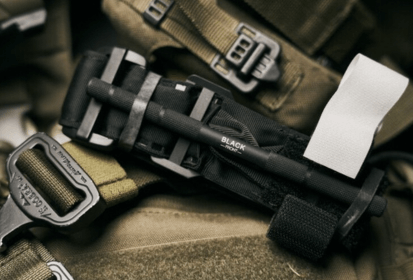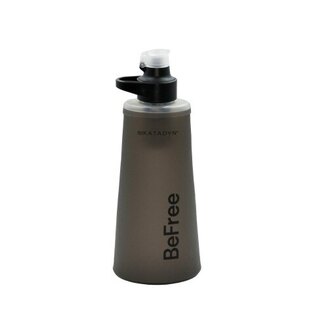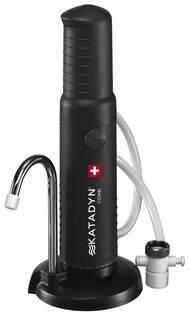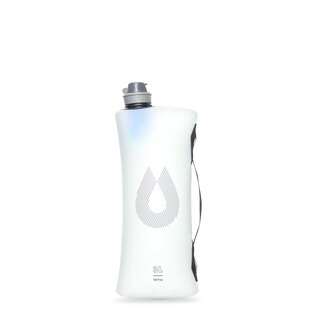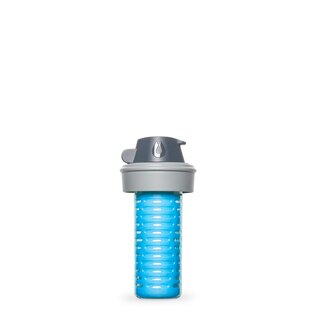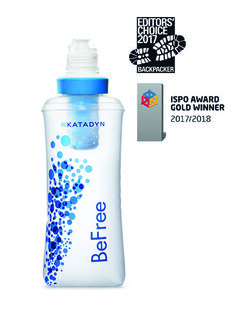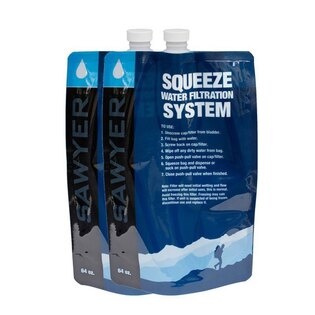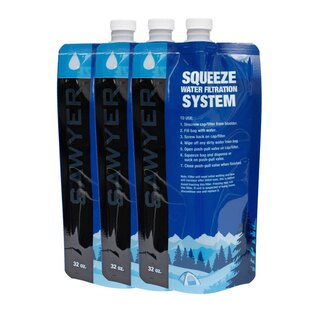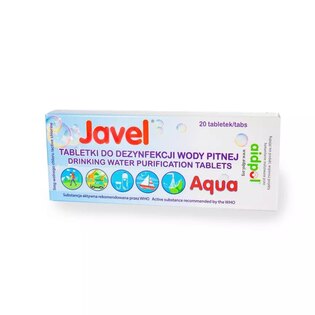Water Filtration in the Field: What to (Not) Do When Using Filters
How to properly use a water filter in the field? A high-quality water filter is only the first step. What truly matters is where you source your water, how you handle the filter, and what you expect from it. This article offers practical advice on how to select the best water source, filter safely and efficiently, understand what affects filter performance in real conditions, and recognize when your filter may no longer be working. You’ll also find tips tailored to different environments, trip types, and real-world use cases.
How to Choose the Best Available Water Source
The quality of the water you collect has a major impact not only on your safety but also on how well your filter performs. The cleaner the source, the less strain on the filter—resulting in better flow, longer lifespan, and more reliable filtration.
When selecting a water source, keep these priorities in mind:
Not all natural water sources offer the same level of safety. Use this color-coded guide for quick assessment in the field:
| ✅ Ideal Sources (Green Zone) | ℹ️ Acceptable Sources (Yellow Zone) | ⚠️ High-Risk Sources (Red Zone) |
|---|---|---|
|
|
|
🔎 Keep in mind: Even the clearest spring can be contaminated—say, by a dead animal upstream. Always filter or treat water, no matter how clean it looks.
What Affects Filter Performance in the Field
No matter what type of filter you use, one rule applies to all: in real-world conditions, performance often depends on more than just technical specs on the box.
Several key factors come into play:
- Water source quality – The murkier or more biologically active the water, the faster your filter will clog.
- Temperature conditions – Freezing can cause irreversible damage to filters, especially hollow fiber models.
- Handling and use – Rough treatment, contamination of the clean outlet, or filtering in the wrong direction can all lead to failure.
- Cleaning and drying – Residual water, sediment buildup, or mold can reduce filtration effectiveness over time.
- Filter type vs. trip type – A gravity filter won’t serve you well while trail running, just as a squeeze filter won’t be sufficient for group use.
👉 Tip: Always consider not just the type of filter, but the specific environment you’ll be using it in—and how you’ll be operating it in the field.
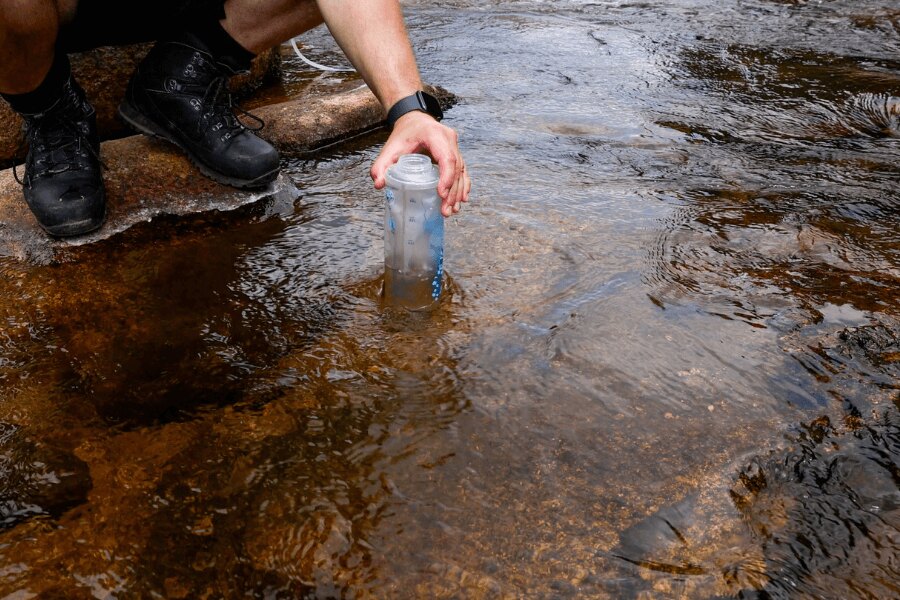
Collecting water from a natural source using a squeeze system – a crucial step before filtration begins.
✅ 9 Rules for Safe and Effective Water Filtration
A water filter isn’t a magical box that takes care of everything on its own. For it to work reliably and last a long time, it needs a bit of attention from you as well. Many issues arise from carelessness, haste, or simply not knowing how to use it properly — and yet most of them can be avoided by following a few simple rules.
Here are nine principles that will help you filter water safely, effectively, and without unnecessary complications.
1. Pre-filter cloudy water
Murky water filled with sediment and organic debris can quickly clog any filter. If your source water is visibly dirty, strain it first through a cloth, shirt, or coffee filter. This helps reduce clogging and extends the life of your filtration system.
2. Don’t drink what has frozen — filter or water
A frozen filter may have internal damage that renders it useless, even if it looks fine from the outside. Likewise, water that has frozen and thawed may no longer be safe to drink. In cold conditions, keep your filter warm — for example, by storing it in your sleeping bag or under your jacket.
3. Consume filtered water immediately or preserve it
Filtered water is not sterile — even trace microorganisms can multiply quickly. If you’re not going to drink it right away, treat it with a chemical disinfectant (e.g., tablets or drops), UV purifier, or by boiling.
4. Keep the clean side clean
Never touch the filter’s clean outlet with dirty hands, let it fall into a puddle, or rinse it with unfiltered water. This is the path water takes straight into your body — treat it with the same care you would a medical needle.
5. Don’t force the filter beyond its limits
Gravity or squeeze filters may offer some resistance — especially with murky water. Don’t try to push harder! Excessive pressure can damage the membrane structure inside. If the flow is slow, clean the filter using a proper backflush instead of applying force.
6. Always follow the correct flow direction
Every filter has a clearly marked flow direction. If you push water through the wrong way, you risk clogging the filter and contaminating the clean side. Only reverse the flow during maintenance (backflushing) — never during regular use.
7. Dry the filter after every use
After filtering, shake out excess water, open the filter, and let it dry completely. Residual moisture can support the growth of microorganisms, which may contaminate your water during the next use. Damp conditions also promote mold and reduce filter lifespan.
8. In winter, keep your filter in your sleeping bag
No joke – in freezing temperatures, store the filter in your sleeping bag overnight. A frost-damaged filter often shows no external signs but may fail when you need it the most. This is especially true for hollow fiber types.
9. Disinfect the filter before long-term storage
Planning to store your filter for the season? Clean it thoroughly according to the manufacturer’s instructions and treat it with a disinfectant solution (such as Micropur). This prevents the buildup of mold and bacteria while it's not in use.
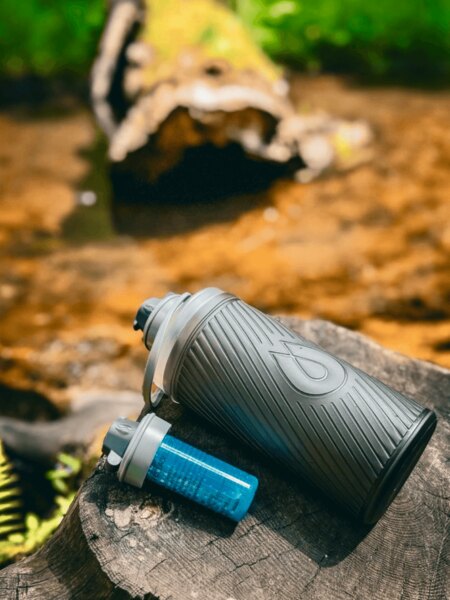
Collapsible Flux™ HydraPak® bottle with 42 mm Cap filter – a compact solution for everyday use and lightweight adventures.
Water Filter Maintenance: How to Extend Its Lifespan
A water filter can serve you reliably for years — but only if you take proper care of it. Even small oversights, like forgetting water inside the filter or failing to dry it thoroughly, can lead to damage or a complete loss of functionality. Not only does this pose health risks in the field, but it can also cost you unnecessary money on repairs or a replacement.
Proper maintenance:
- significantly extends the lifespan of your filter,
- saves you money on replacement cartridges or new units,
- helps maintain flow rate and filtration efficiency,
- and most importantly: ensures your filtered water remains safe to drink.
Key Principles of Proper Water Filter Maintenance
🟠 Clean after every use
After returning from a trip, always clean your filter thoroughly following the manufacturer’s instructions. For most mechanical filters, this involves flushing it with clean water (often via backflushing).
🟠 Never leave water inside
Residual water can lead to bacterial growth or freezing damage. Always drain, shake out, and air-dry your filter completely after use.
🟠 Avoid freezing
Hollow fiber filters (e.g. squeeze or gravity systems) are extremely sensitive to freezing. Once frozen, they may develop invisible microcracks that compromise their performance and reliability.
🟠 Replace carbon components regularly
Filters with activated carbon (used to reduce odors and chemicals) require periodic replacement — typically after several hundred liters.
🟠 Store in a clean, dry place
Once dried, store your filter somewhere clean and dry. Long-term exposure to moisture can promote mold growth or degrade materials.
🟠 Disinfect before long-term storage
If you're not planning to use the filter for a while, it’s worth disinfecting it — for example, using a chlorine solution or a special cleaner recommended by the manufacturer.
🟠 Track the lifespan of your filter element
Every filter has a usage limit (e.g. 1,000 liters or 6 months). Even if it still “works,” it may no longer provide reliable protection once that limit is exceeded.
🔧 Recommended Filtration Accessories
These small extras can make your water filtration setup much easier to use in the field—and often extend the life of your filter:
- Dirty water bag – makes collecting water from natural sources easier
rigad.com/jerrycans-water-containers - Hose – connects your filter to a bottle or reservoir; ideal for gravity systems
- Check valve – prevents backflow or contamination of the clean side
- Flush syringe – essential tool for backflushing squeeze filters
- Waterproof pouch or dry bag – protects your filter and accessories from moisture and damage
rigad.com/waterproof-pouches, rigad.com/waterproof-bags-sacks - Fabric pre-filter – bandana or mesh to capture larger debris before filtration
- Filter accessories – adapters, replacement parts, hoses, and more
rigad.com/water-filters-accessories
Each type of filter has slightly different requirements, but there are a few universal principles that are always worth keeping in mind…
💧 Maintenance for Different Filter Types
Different types of filters require different care. Following the recommended maintenance will significantly extend their lifespan and ensure reliable performance in the field:
-
💧 Gravity filters
HydraPak® Water Filter, 28 mm
– Backflush regularly
– Avoid pulling on the reservoir to prevent membrane damage
– Let it dry thoroughly after use -
💧 Pump filters
Hiker Pro KATADYN®, Combi Plus KATADYN®
– Drain after each use
– Replace the carbon cartridge as instructed
– Maintain pistons and seals to prevent leaks -
💧 Bottle filters
S1 Foam Filter SAWYER® Bottle, Tactical BeFree KATADYN®
– Replace foam filter regularly (S1)
– Rinse and dry after use
– Do not use with oily or chemically contaminated water -
💧 Squeeze filters
HydraPak® Cap, 42 mm
– Backflush after every use
– Do not expose to freezing temperatures—hollow fibers can crack
– Dry and disinfect before long-term storage -
💧 Chemical treatments
Overview of chemical treatments
– Follow the recommended contact time
– Store in a cool, dark place
– Check expiration dates regularly
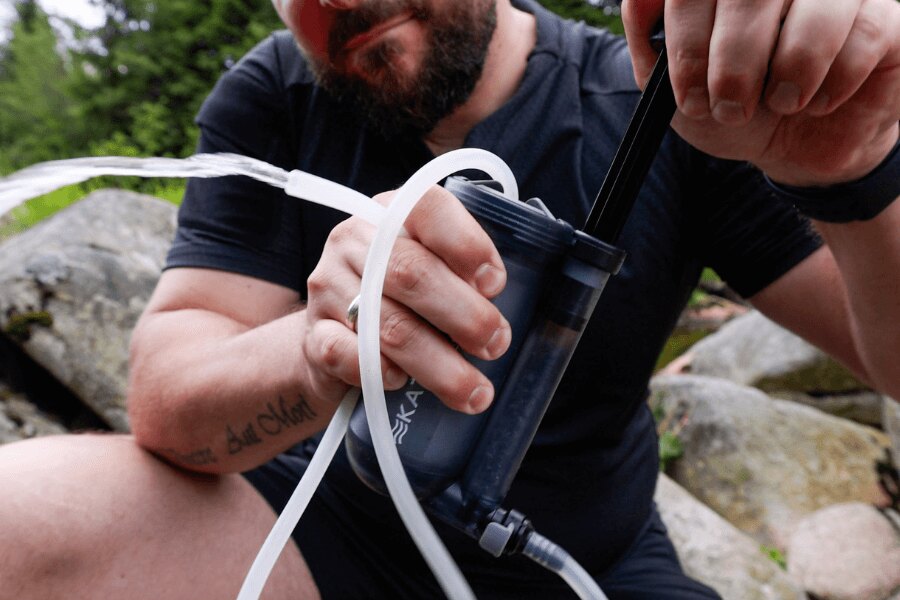
Katadyn® Hiker Pro pump filter in action – ideal for groups and challenging water sources.
How to Tell If Your Water Filter Has Stopped Working
A failing water filter doesn’t always show obvious signs—which makes it a hidden risk. When using your filter, watch for the following indicators that its performance may be compromised:
Possible signs of reduced effectiveness:
⚠️ Noticeably slower flow rate that doesn’t improve after backflushing
⚠️ Unusual taste in filtered water, even after replacing the carbon element (if present)
⚠️ Cloudiness or visible particles in the filtered water
⚠️ Visible damage to the filter—cracks, loose seals, peeling membranes
⚠️ Exposure to freezing temperatures—especially for hollow fiber filters, which may suffer internal damage that isn’t externally visible
⚠️ Exceeding the filter’s lifespan (e.g. 1,000 or 10,000 liters, depending on model)
👉 If you’re unsure about your filter’s condition, don’t use it. The risk of gastrointestinal infections and dehydration in the field is never worth a questionable sip.

Flux™ HydraPak® collapsible bottle and HydraPak® Water Filter (28 mm) – a lightweight, packable solution for quick hydration in the field.
What Water Filters (Usually) Don’t Remove
Even the best water filter has its limits. Mechanical membrane filtration doesn’t address every type of contaminant—particularly those of chemical or viral origin. This is especially important to keep in mind in urban environments, developing countries, or during emergencies.
Common contaminants that most filters do not remove:
❌ Viruses – are smaller than the pores of regular filters. They are more commonly found in tropical areas or urban water.
❌ Heavy metals – Such as lead, arsenic, or mercury, often from industrial runoff or aging infrastructure.
❌ Pesticides and herbicides – Common in agricultural areas; these often end up in surface water sources.
❌ Chemicals and toxins – Includes petroleum-based substances, solvents, fertilizers, etc.
❌ Minerals – Filters do not affect water hardness or salt content.
👉 The solution:
Supplement your filter with an additional treatment method suited to the type of contamination:
- UV sterilization
- Boiling
- Distillation (as a last resort)
🛑 If you’re unsure about what’s in the water, don’t filter blindly.
Water Filtration in the Field: Key Takeaways
Effective water filtration isn’t just about choosing the right filter. Equally important is how you use it, which water source you collect from, and how well you maintain your gear. Most common mistakes stem from oversight or haste—but with a little attention, they’re easy to avoid.
🛠️ Recommended Products from Rigad
Different environments call for different filtration systems. Here's an overview of suggested solutions based on terrain and expedition style:
-
🥾 Solo Expeditions, Trail Running, Bikepacking
💧 HydraPak® Cap, 42 mm – ultralight squeeze filter for fast-paced adventures
💧 Tactical BeFree KATADYN® Bottle – drink directly from the bottle with no waiting -
👨👩👧👦 Groups and Families
💧 Combi Plus KATADYN® Portable Filter – ideal for basecamps and larger groups -
🏕️ Camping and Basecamps
💧 HydraPak® Water Filter, 28 mm – gravity-based system, no pumping required -
🌍 Tropical Regions and Urban Areas
💧 S1 Foam Filter SAWYER® Bottle – removes viruses, chemicals, and unpleasant taste
💧 Micropur Katadyn® Water Treatment – essential for tropical and heavily contaminated water sources
Remember:
- A clean water source = less strain on your filter
- Regular maintenance = longer filter lifespan
- Safe habits = lower risk of contamination
Don’t underestimate the small stuff when filtering water outdoors. Even minor practices can make a major difference for your health and the smooth flow of your trip.
Readers are further interested

